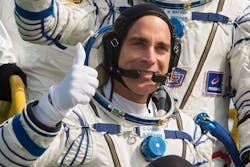Rest assured that US astronauts have not been neglecting the plants on the International Space Station, even if they were engaging in higher-profile activities such as spacewalks before two of them splashed down in the Gulf of Mexico yesterday.
In fact, the one who is still up there — Chris Cassidy — has taken on yet another LED horticultural task to go along with the continuing onboard botanical lighting projects that LEDs Magazine has written about previously.
In the newest case, the objective of the horticulture is as much about testing an imaging system as it is about studying plant growth.
LEDs has learned that Cassidy spent a considerable part of two days in June setting up what NASA calls Spectrum-001. The system uses white and tunable LEDs to nurture the growth of small plants and yeasts in petri dishes. The specimens had been genetically modified on Earth to include fluorescent proteins, which provide markers picked up by different wavelengths of light emitted by Spectrum.
It appears as though fellow astronauts Bob Behnken and Doug Hurley hauled up the dishes as part of the payload they delivered when they docked with the space station on May 31, 19 hours after they became the first crewed mission to blast off from US soil in nearly a decade. The pair traveled there and back in the Crew Dragon capsule provided by Elon Musk’s SpaceX company, returning yesterday, Aug. 2. During that time, Cassidy and Hurley went on four spacewalks, supported by Behnken.
They’ve tended to plenty of other duties as well.
Cassidy, who has been aboard the ISS since April on a half-year mission, will continue keeping an eye on Spectrum-001 and its two dishes of thale cress and one dish of yeast. So will scientists back home, where a research team is receiving images transmitted by Spectrum. Principal investigators include scientists from the University of Wisconsin, according to NASA’s Spectrum webpage.
The idea, like with many experiments on the station some 220 miles high, is to examine how things work in microgravity in order to develop them for future use in space. Researchers are analyzing specimen growth as well as the imaging system itself.
“The goal of the Spectrum-001 investigation is to demonstrate the capabilities of the Spectrum imaging hardware on the International Space Station (ISS),” NASA states. “The Spectrum images are analyzed by the research team for changes in fluorescence and morphology in order to assess the biological changes induced in the samples by growth in Spectrum on the ISS and to help characterize Spectrum’s on-orbit imaging capabilities....Collection of images is a vital capability for microgravity life science research that uses organisms grown in petri plates. The data from this demonstration should improve that capability and contribute to a better understanding of biological responses to the stresses of spaceflight.”
There could also be benefits for anyone who might not have the chance to travel to space.
“The capability to obtain more detailed observations using this new technology could lead to more discoveries of cell and tissue functions, supporting innovations for biomedical and agricultural applications on Earth,” NASA says.
Meanwhile, at least two other LED horticultural projects are continuing on the ISS: the Advanced Plant Habitat and Veggie PONDS.
MARK HALPER is a contributing editor for LEDs Magazine, and an energy, technology, and business journalist ([email protected]).
For up-to-the-minute LED and SSL updates, why not follow us on Twitter? You’ll find curated content and commentary, as well as information on industry events, webcasts, and surveys on our LinkedIn Company Page and our Facebook page.





